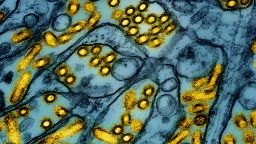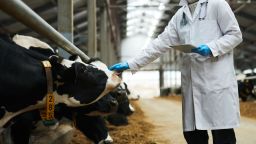The highly contagious H5N1 virus ravaged a flock of chickens at a secure breeding farm specializing in hybrid birds with unique feather and egg colors. A nearby facility, owned by the same company, also experienced an outbreak.
Despite strict biosecurity measures—including filtered well water, one-way air circulation, and sturdy fencing to keep out wild animals—the virus still infiltrated the farms. Employees weren’t even allowed to raise their own chickens at home.
Investigators determined that a unique combination of factors allowed the virus to be carried by the wind onto the chicken farm. While wild birds are the primary source of H5N1 transmission, experts have long suspected airborne spread as a possible route.

Dr. Richard Webby, director of the WHO’s Collaborating Center for Studies on the Ecology of Influenza in Animals, noted that proving windborne transmission is challenging. However, similar concerns have been raised in recent H5N1 outbreaks among cattle herds in California’s Central Valley.
Although airborne spread raises questions, Webby emphasized that the current H5N1 strains infecting animals are not easily transmissible to humans. Even if the virus is airborne, the concentration in the air is likely too low to pose a significant risk to people.
The outbreak in the Czech Republic
Scientists traced the Czech Republic’s chicken farm outbreak to a duck-fattening farm nearly five miles away. This facility, unlike the high-security chicken farm, had minimal biosecurity and was located near a lake where wild ducks gathered.
Bird flu spread rapidly among the 50,000 ducks, killing thousands within days. To control the outbreak, the entire flock was culled. Meanwhile, at the chicken farm, infections progressed more slowly, with the first sick birds located near the barns’ air intake vents.

Genetic analysis confirmed that the H5N1 strains found at the duck farm were identical to those infecting the chickens, indicating the virus had spread from one farm to the other. However, no human or physical links between the facilities could be found.
The role of weather
Researchers then examined weather conditions during the outbreak. A steady westward breeze, extensive cloud cover that blocked UV light, and cool but non-freezing temperatures created an ideal environment for the virus to survive and travel through the air.
Dr. Kamil Sedlak, lead researcher from the State Veterinary Institute in Prague, concluded that under these specific conditions, windborne transmission was the most plausible explanation.
Experts, including Dr. Montse Torremorell of the University of Minnesota, found the findings compelling. Previous studies have detected high levels of avian influenza viruses in the air near poultry and swine farms, suggesting airborne particles may contribute to outbreaks.

A complex challenge
While wind-driven spread presents new challenges, experts caution against assuming the virus is unstoppable. Lessons from the COVID-19 pandemic highlight the importance of layered protection strategies.
Existing biosecurity measures—such as limiting farm access and using personal protective equipment—should continue. However, additional precautions, like air filtration in barns, may help mitigate the risk of airborne transmission.
Dr. Michael Osterholm, director of the Center for Infectious Disease Research and Policy at the University of Minnesota, believes windborne H5N1 transmission is happening more frequently due to widespread infections in aquatic birds. He speculates that wind over contaminated water bodies could carry the virus to nearby farms.
With H5N1 outbreaks occurring across the country, Osterholm suggests wind-driven spread may explain cases where direct animal contact wasn’t identified, such as veterinarians testing positive for H5N1 antibodies despite no known exposure to sick animals.
While the risk to humans remains low, the possibility of airborne transmission reinforces the need for continued vigilance in monitoring and containing the virus.